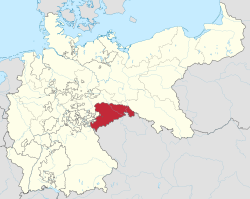
Back مملكة ساكسونيا Arabic مملكة ساكسونيا ARZ Saksoniya (krallıq) Azerbaijani ساکسونیا کراللیغی AZB Каралеўства Саксонія Byelorussian Кралство Саксония Bulgarian স্যাক্সনি রাজ্য Bengali/Bangla Rouantelezh Saks Breton Regne de Saxònia Catalan Saské království Czech
Kingdom of Saxony Königreich Sachsen | |||||||||
|---|---|---|---|---|---|---|---|---|---|
| 1806–1918 | |||||||||
| Anthem: Sachsen Hymne | |||||||||
 Kingdom of Saxony within the German Empire | |||||||||
| Capital | Dresden | ||||||||
| Government | Monarchy | ||||||||
| King | |||||||||
• 1806-1827 | Frederick Augustus I | ||||||||
• 1904-1918 | Frederick Augustus III | ||||||||
| History | |||||||||
• Established | 1806 | ||||||||
• Disestablished | 1918 | ||||||||
| Area | |||||||||
| 1910 | 14,993 km2 (5,789 sq mi) | ||||||||
| Population | |||||||||
• 1910 | 4806661 | ||||||||
| |||||||||
The Kingdom of Saxony (German: Königreich Sachsen), existed from 1806 until 1918.
From 1871 it was part of the German Empire, and after World War I it became part of the Weimar Republic. Its capital was the city of Dresden, and its modern successor state is the Free State of Saxony.
Before 1806 Saxony was the Electorate of Saxony in the Holy Roman Empire. This meant that the princes who ruled Saxony were prince-elector and could help elect a new Holy Roman Emperor.
When Emperor Francis II was defeated by Napoleon at the Battle of Austerlitz and the empire was dissolved the electorate became an independent kingdom. The last elector of Saxony became King Frederick Augustus I.
After the Battle of Jena in 1806, Saxony joined the Confederation of the Rhine, and remained within the Confederation until it broke up in 1813 when Napoleon was defeated at the Battle of Leipzig.
The Catholic ruler of Saxony was one of the few German leaders to support the French. Saxony was put under Russian occupation and 40% of the Kingdom, including the historically significant Wittenberg, home of the Protestant Reformation, was taken by Prussia, but Frederick Augustus was allowed back to rule the remainder of his kingdom, which still included the major cities of Dresden and Leipzig. The Kingdom also joined the German Confederation, the new organization of the German states to replace the Holy Roman Empire.

